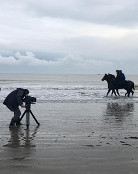Donn's Articles » Ballydoyle
Ballydoyle
When the embers of the 2010 flat racing season have glowed their final glow, it is probable that we will look back at Midas Touch’s win in the Derrinstown Stud Derby Trial at Leopardstown on Sunday as the buoy around which the great ship Ballydoyle turned.
The Derrinstown is a race that Ballydoyle like to win, and they like to win it with good horses. Seven of the last 10 renewals of the race have now been won by a colt that has been sent forth by Aidan O’Brien, and the previous six all went on to win Group 1 contests, four of them an Epsom Derby or an Irish Derby, or both.
Ironically, Midas Touch may not have even run in Sunday’s race if Mikhail Glinka had been fit, but you don’t need Walt Disney’s imagination to envision Sue Magnier’s colt going well in this year’s Derby. There were only four horses in Sunday’s race, but they went a solid pace, and the time was good, over a second and a half faster than standard and the fastest Derrinstown in 20 years. The attitude that Midas Touch displayed was admirable and, by Galileo out of a Darshaan mare from a top middle distance family, he is almost certain to improve for the step up to a mile and a half. Furthermore, coming from Ballydoyle, you know that he will improve significantly for this run.
That’s the thing about the Ballydoyle horses, they almost always improve for their early-season debuts. The whole team improve as the season develops. If you plotted a graph with Time on the X-axis (isn’t it always?) and Performance on the Y-axis, the annual trend for Team Ballydoyle would be steeply inclining. Yet, no matter how long we are at this game, no matter how well-established the pattern is now, the perennial murmurings of concern for the quality of the Ballydoyle horses are now an integral part of the early-season Fanzone.
In one sense, you can understand the disquiet. Like any sport, racing is a results-driven business, and patience is not a quality that sports fans possess any more. But to begin to pass judgement in early May is to ignore the pattern and the training methodology, designed for longevity, that has now been well established.
In 2006, Aidan O’Brien had just two winners from 17 runners in Ireland before 1st May, a strike rate of 11%, compared to a strike rate of 21% for the remainder of the season. 2007 was a bit of an anomaly, in that his strike rate before 1st May was 20%, which was the same as it was for the entire season. However, normal service was resumed in 2008, with a strike rate before 1st May of 12%, compared with 20% for the season, while last year his early strike rate was 10%, compared with 21% for the entire season. This boat is built for the long haul.
That said, there have been disappointments. There is no doubt that St Nicholas Abbey was disappointing in the Guineas. When an even money shot finishes sixth in a Classic, you have to be disappointed. In mitigation, the one-mile Classic was always going to be St Nicholas Abbey’s most difficult assignment this year. He is bred for middle distances, he never raced over less than a mile last year, and the Group 1 race that he won as a juvenile was the Racing Post Trophy, the juveniles’ Derby trial. It is not a coincidence that three of the previous eight Racing Post Trophy winners won the Derby the following season, and that one of them won the St Leger.
Also, there is a chance that the son of Montjeu needed more time. He wasn’t confirmed as a definite intended runner in the Guineas until Steinbeck was ruled out, and that may have left his trainer with insufficient time to tighten the screws for a one-mile dash. The Guineas these days happens upon you early in a season that goes on through the Arc in October and the Breeders’ Cup, well into November (Jan Vermeer won his Group 1 race at Saint-Cloud on 1st November last year), and the Ballydoyle Guineas horses can often be a fair way ahead of their stable companions out of necessity. Remember that, in 2007, when Holy Roman Emperor was their Guineas horse before he was whisked down the road to Coolmore to fill the void that had been left by George Washington, there just didn’t seem to be enough time to get subsequent Group 1 winners Eagle Mountain and Duke Of Marmalade up to Guineas-winning level. The St Nicholas Abbey bandwagon has not stopped rolling yet.
The Ballydoyle horses that contested the three Classic trials at Chester last week did come up a fair way short, and it was desperate to lose a potentially smart colt like Captain James Cook at Lingfield on Saturday, but you always get the feeling at Chester’s Classic trials that there are better ones at home.
The next four weeks are important weeks for Ballydoyle. The period starts with Cabaret in the Musidora Stakes at York tomorrow and Cape Blanco in the Dante on Thursday, and it ends with the Derby at Epsom on 5th June. It was Federico Tesio, the top Italian breeder and statesman, who said that “the thoroughbred exists because its selection has depended, not on experts, technicians, or zoologists, but on a piece of wood: the winning post of the Epsom Derby.” That is a notion that the Ballydoyle/Coolmore axis has embraced like no other. They haven’t won it since High Chaparral and Hawk Wing completed a 1-2 in 2002, but seven of the first 12 horses in the Derby betting this morning are Ballydoyle horses.
It could be that the wind is just starting to fill the sails.
© The Racing Post, 11th May 2010


 Follow Donn
Follow Donn